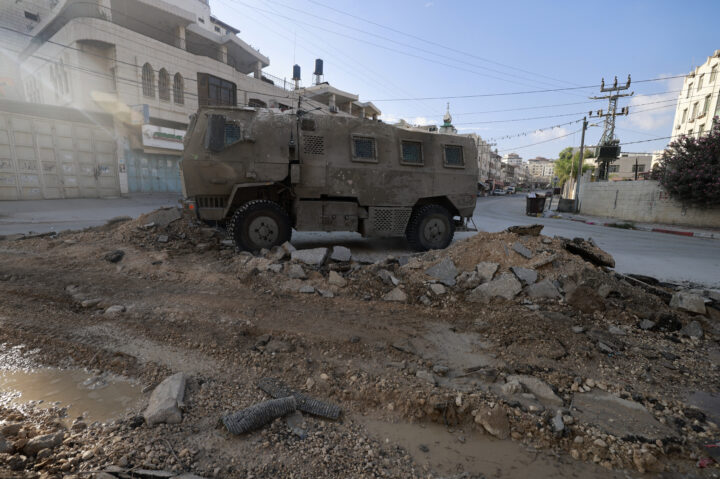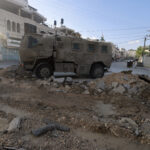As tensions soar in the West Bank, IDF launches new offensive operation
Former IDF spokesman Jonathan Conricus explained to Jewish Insider that the ‘geographical structure of Samaria is such that it dominates all the areas around it and the introduction of certain weapons in those areas would be a real game changer for the State of Israel.’

JAAFAR ASHTIYEH/AFP via Getty Images
An Israeli military vehicle drives down a road during a raid in northern city of Tulkarm in the West Bank on August 28, 2024.
While most of the international focus of Israel’s current war has been on Gaza and Lebanon, over the past 11 months tensions have also soared in the West Bank, with various Palestinian militant factions – some with direct backing from Iran – carrying out violent terror attacks against Israeli civilians and soldiers. The attacks have included placing explosive devices on roadways, shooting at civilian vehicles and even dispatching a bomber to the heart of Tel Aviv for the first time in more than 15 years.
Israel has responded by sending its troops deeper into Palestinian towns and cities, as well as conducting more than 60 airstrikes, using an array of drones, attack helicopters and fighter jets to hit terror targets and cells from above.
On Wednesday, 10 days after a Palestinian terrorist attempted – but failed – to place a bomb in central Tel Aviv, the IDF announced it was launching a full-scale military operation in Jenin, Tulkarem and the Jordan Valley, areas from which most of the recent terror has emanated.
IDF international spokesman Lt. Col. Nadav Shoshani told journalists that there had been more than 150 shooting and explosive attacks, most originating from the northern part of the West Bank.
According to reports, some 27 Israelis, including security personnel, have been killed in terror attacks in Israel and the West Bank since Hamas carried out a mass terror attack on Oct. 7, sparking a full-scale war in the Gaza Strip and rising tensions on Israel’s border with Lebanon. Among Palestinians, the United Nations Office of Humanitarian Affairs (OCHA) reports that more than 600 have been killed as a result of IDF operations in the West Bank.
“One of the lessons learned from the Oct. 7 massacres is that we need to operate to remove terror threats in real time across all our arenas and to make sure attacks that that can kill our civilians do not happen,” Shoshani said in his briefing, highlighting a pre-emptive military strike earlier this week against the Iranian-backed Shiite militia Hezbollah in Lebanon, which was reportedly planning to fire thousands of rockets and missiles into Israel.
Shoshani said that terrorism in the West Bank was not new but that since the start of the war in Gaza, the threats against civilians and troops have been steadily increasing and the type of terror acts intensifying.
“During this time, we have seen many explosives being planted on the roads in Judea and Samaria,” said the spokesman, using the biblical name used by Israelis for the West Bank.
He also said that there had been attempts by Iran to smuggle weapons in the area, part of “a systematic strategy by Iran to fund, arm and support terrorist groups across the Middle East.”
“The counter terrorism operation that started [on Wednesday] aims to target terror infrastructure and we are making sure we do not harm [Palestinian] civilians,” Shoshani added. He would not give more details on the scale of the operation or its expected duration.
Palestinians reported on Wednesday that at least nine people were killed overnight in a series of drone strikes and clashes with Israeli forces. The IDF said in a statement that the raid, which included soldiers from the Kfir Brigade and Duvdevan Commando Unit, as well as combat engineers, had focused on the area of Tulkarem, with some activity in Jenin and Far’a, near the town of Tubas, in the Jordan Valley.
On Thursday, the army announced that it had killed an additional five terrorists, including Muhammed Jabber, the head of a terrorist network in Nur Shams, in clashes overnight in Tulkarem. The IDF also said it had located an operations center and an explosives lab hidden in a mosque in the Jordan Valley.
“I think we’re seeing the first stage of an inevitable and long overdue Israeli operation in the northern part of Samaria, focusing on Tulkarem and Jenin and Far’a in the Jordan Valley,” Jonathan Conricus, a senior fellow for the Foundation for the Defense of Democracies, told Jewish Insider.
“We’ll likely see similar operations in Nablus, perhaps Jericho, in the near future,” he continued, adding that it would mark a shift in Israel’s “position along the Jordan border as it erects defenses, tech and troops to make it much more difficult for weapons to be smuggled in.”
Conricus, a former IDF spokesman, added that while Tulkarem and Jenin have been hotbeds of terror in recent years, the more interesting targets of the army’s current operation were the locations in the Jordan Valley.
“To me, that’s the most important one because that is where the weapons are coming in from — across the Jordanian border,” he said. “It’s a race against time, because up until now, terrorist organizations have not been able to get their hands on strategic, game-changing weapons such as high-quality anti-tank missiles, explosive devices and surface to air or shouldered missiles.”
“When and if they do,” Conricus added, “it could force the IDF to go from motorized operations with vehicles such as jeeps, to the armored and heavy mechanized vehicles and that’s a totally different footprint, totally different logistics, and would have very different consequences on the population and the infrastructure.”
He explained that there was “much less strategic flexibility for Israel in this area … when it comes to Judea and Samaria, the danger is much more immediate because of its proximity and the lay of the land.”
“I would say this is double jeopardy for Israel because there are more than half a million Israelis living in Judea and Samaria and they are at direct risk [from the terror activities],” Conricus said, pointing out that “Tulkarem is a stone’s throw away from road six and is very close to lots of Israeli communities on the other side of the Green Line.”
“The geographical structure of Samaria is such that it dominates all of the areas around it and the introduction of certain weapons in those areas would be a real game changer for the State of Israel,” he said.
Brig. Gen. (retired) Amir Avivi, CEO of the right-wing Israel Defense and Security Forum (IDSF), also said that the rise in tensions in the West Bank stemmed from Iranian efforts to strengthen and weaponize terror groups there, alongside its other terror proxies in Gaza and Lebanon, in an attempt to destabilize Israel.
“Over the past two or three years, and especially since Oct. 7, Iran is trying to ignite the area of Judea and Samaria by sending in huge amounts of money and smuggling in weapons through the Jordanian border,” Avivi told JI, describing the actions of terror groups such as Palestinian Islamic Jihad and Hamas, as well as independent factions and those belonging to Fatah, the group that essentially runs the Palestinian Authority.
Avivi said that in response, the IDF had deployed operational tactics never really seen before in the West Bank arena, such as “utilizing the air force to target terrorists in cars and headquarters.”
He also said that the situation was a direct result of a 2005 Israeli government decision to disengage from the area of Jenin and the Jordan. In that year, the government under then-Prime Minister Ariel Sharon took the controversial decision to dismantle several army bases and a handful of civilian towns in the northern part of the West Bank, as well as removing Israel’s entire presence from the Gaza Strip.
The pull-out from those areas, explained Avivi, has meant that it is far more difficult for the army to maintain calm and “now the IDF Central Command has launched this large operation to dismantle as much terror infrastructure as possible to prevent groups from carrying out terror attacks against Israelis in Judea and Samaria and in central Israel.”
Avivi argued the somewhat controversial opinion that the presence of Israeli civilians, some of them armed, living in the West Bank was helpful for the army, freeing it up so it can “deal with an offensive operation.”
“Every town is a military outpost that brings security,” he said. “If, on Oct. 7, our towns were armed the way they were supposed to be, they might have been able to stop Hamas’ attack from Gaza.”
Meanwhile on Wednesday, Israel’s Foreign Minister Israel Katz called on the army to consider temporarily relocating West Bank Palestinians as part of the operation.
“We need to deal with this terror threat exactly as we deal with terror infrastructure in Gaza, including the temporary evacuation of Palestinian civilians and any other step needed,” he wrote in a post on X, calling the operation “a war in every sense.”
Shoshani, the IDF spokesperson, said he was unaware of any plans to relocate the Palestinian civilian population as part of the West Bank operation.










